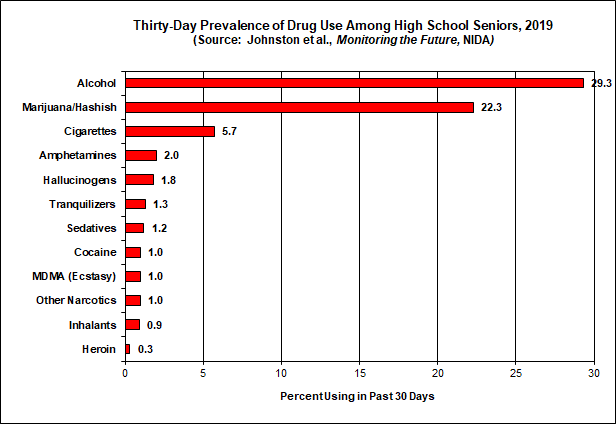Epidemiology of Alcohol Use and Alcohol-Related ProblemsPart 2. Prevalence Rates: Monitoring the Future |
||
Most epidemiological research on alcohol use and drinking problems focuses on the prevalence of substance use. Generally, prevalence refers to the rate of existing cases or conditions, both new and ongoing, at a given point in time (or during a period of time). The Monitoring the Future (MTF) project at the University of Michigan is a particularly useful source of data on the prevalence of illegal substance use by adolescents. This project has been collecting data on drug use, drug-related attitudes, and background factors among high-school seniors since 1975, and it continues to conduct school-based sample surveys of seniors and younger adolescents (8th and 10th graders) annually. The 2019 annual MFT survey collected data from approximately 50,000 students in 420 secondary schools. Samples of high-school seniors were selected using probability sampling methods to be representative of all seniors in public and private high schools in the continental U.S. For a more detailed overview of the main findings from this national survey, take a look at the December 18, 2019 press release from the MTF project (click here). The MTF survey provides four measures of the prevalence of drug use among adolescents: (a) lifetime prevalence ("on how many occasions [if any] have you used...in your lifetime?"); (b) annual prevalence ("...during the past 12 months?"); (c) thirty-day prevalence ("...during the last 30 days?"); and (d) so-called daily prevalence (at least 20 days in the last 30 days). Although the media often focus on estimates of lifetime use because this measure yields the most inclusive--and, thus, largest--prevalence figures, many drug researchers find thirty-day prevalence to be the most useful measure of ongoing drug use. The primary limitation of the MTF data is the exclusion of students who are absent from school during the administration of the survey due to truancy, drop-out, or disciplinary action. Nonetheless, these data give us the most complete, representative, and long-term epidemiological portrait of adolescent drug and alcohol use in the U.S. The following graph shows the thirty-day prevalence estimates for 12 different substances in the 2019 MTF survey of high-school seniors. Three out of ten seniors report having used alcohol on at least one occasion during the past month. Marijuana was used by 22.3 percent of high-school seniors in the past month, making it by far the most commonly used illegal drug in this age group. Only 5.7 percent of seniors smoked at least one cigarette in the last 30 days. Aside from these three substances, the thirty-day prevalence rate for the use of all other substances fell at or below 2.0 percent of high-school seniors. |
||
 |
||
| Previous Page | Next Page | |